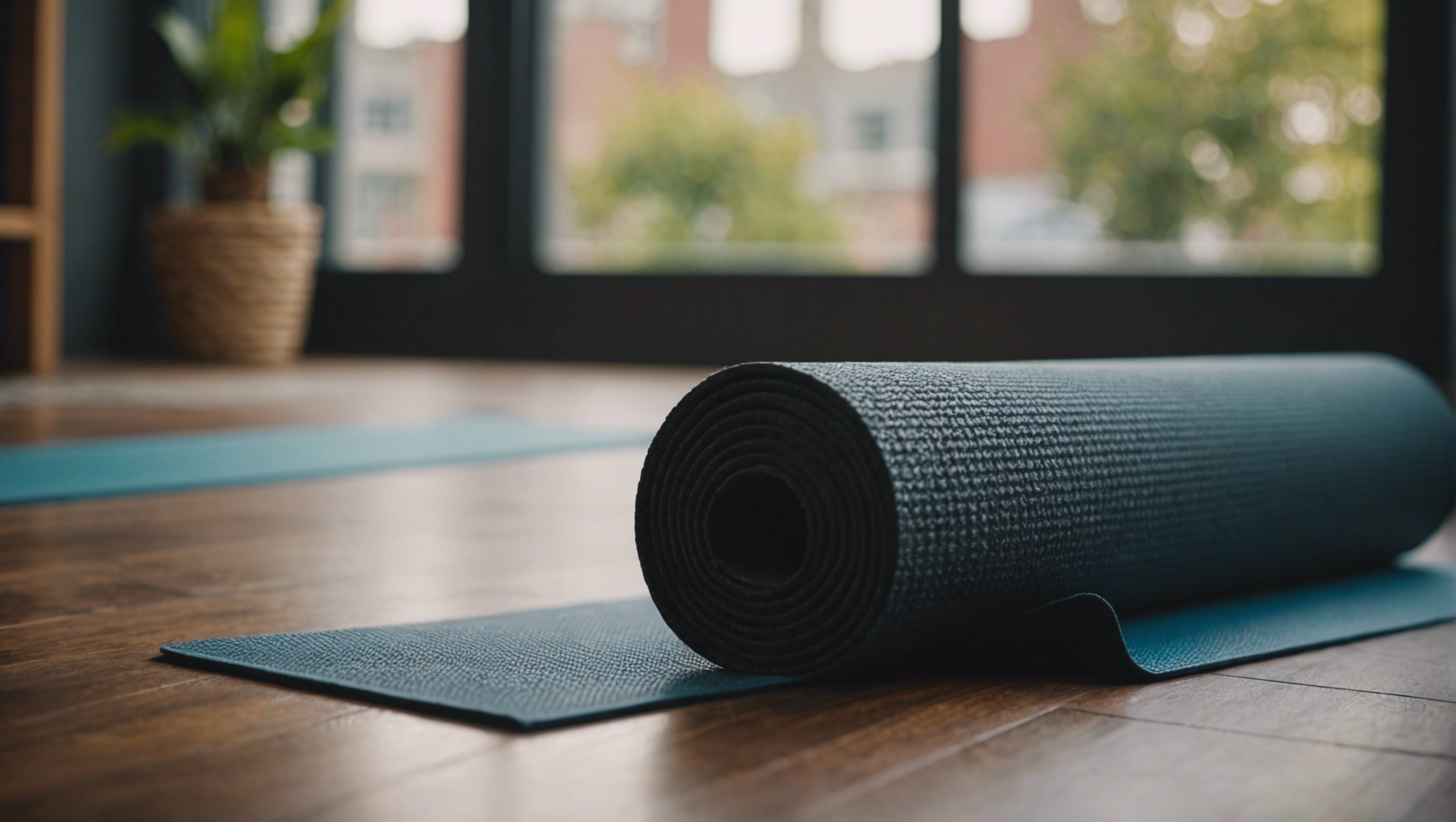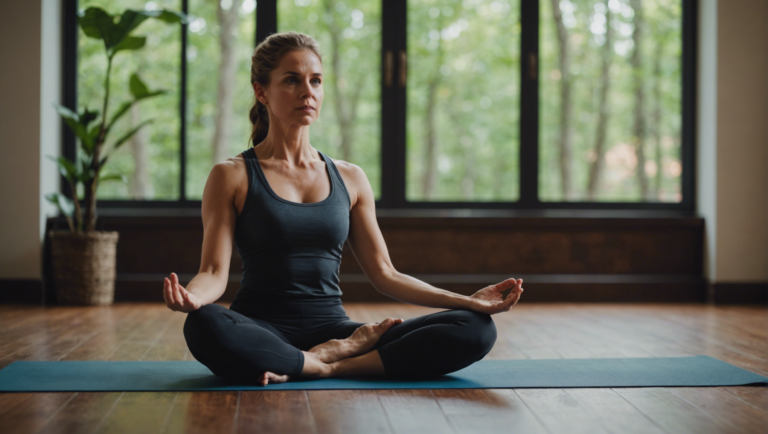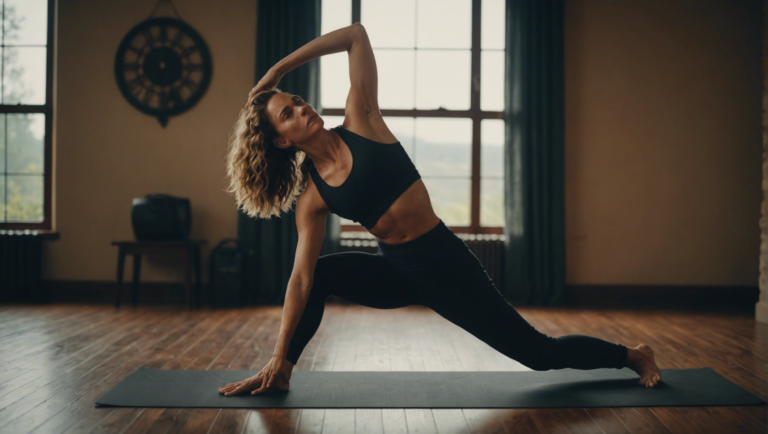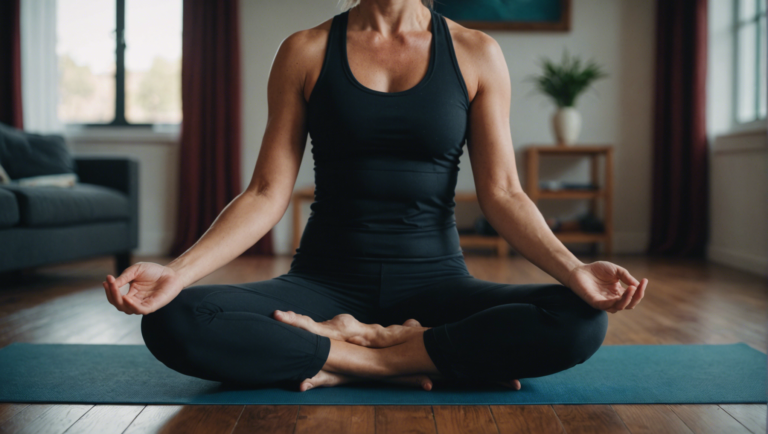Essential Guide: What Yoga Mat Should I Buy?
Decoding the Dilemma: Which Yoga Mat Should I Buy?
Navigating the vast sea of yoga mats available in the market can feel overwhelming. Selecting the right one is crucial not just for comfort, but for enhancing your practice, ensuring safety, and aligning with your personal values and needs. This comprehensive guide delves into the essential factors to consider when choosing a yoga mat, providing you with the knowledge to make an informed decision.
Understanding the Significance of Thickness and Material
The thickness of a yoga mat can greatly impact your practice. A standard mat typically ranges from 1/8 inch (about 3 mm) to 1/4 inch (about 6 mm) thick. Thinner mats (1/16 inch, or about 1.5 mm) offer better connection to the floor, which is essential for stability in standing poses, but might be uncomfortable during longer sessions or on hard surfaces. Thicker mats, on the other hand, provide extra cushioning and are ideal for restorative or Yin yoga practices, yet they can make it harder to feel a strong connection to the ground.
The material of the mat not only affects the texture, stickiness, and eco-friendliness but also its durability and how it wears over time. Common materials include PVC (durable and easy to clean but not environmentally friendly), TPE (a more eco-friendly PVC alternative), natural rubber (offers excellent grip and eco-friendly but may cause allergies), and cork (sustainable, naturally antimicrobial but can vary in grip when dry).
Deciphering the Grip and Texture Puzzle
A mat’s grip is crucial to prevent slipping and sliding, ensuring safety throughout your practice. This is particularly important for dynamic styles of yoga or if you tend to sweat a lot. Texture, whether it’s a pattern or a tactile material like jute, can also add grip. However, it might not be comfortable for all practitioners, especially in poses where much weight is placed on the hands or knees. Mats with a smooth surface might offer less physical grip but can be more comfortable for flowing movements and longer holds.
Eco-friendliness and Hygiene Factors
For many practitioners, the environmental impact of a yoga mat is a significant consideration. Eco-friendly mats are typically made from natural or recycled materials that are biodegradable or sustainable. While they may come with a higher price tag, their environmental benefits often outweigh the cost.
Hygiene is another crucial factor. Some materials are naturally antimicrobial, while others are designed to be easy to clean and resist the buildup of odors and bacteria. Consider how easy it is to clean the mat and how well it stands up to sweat and dirt, especially if you practice regularly or in a hot yoga class.
Aligning with Your Practice and Lifestyle
Your specific practice style and where you practice should influence your choice. For instance, if you travel frequently or walk to a yoga studio, a lightweight and portable mat might be your best option. On the other hand, if you practice mainly at home or enjoy more restorative styles, a heavier, thicker mat could be more suitable.
Price Point and Longevity
Consider your budget and how often you practice. Higher-priced mats might offer better durability and eco-friendly materials, making them a worthwhile investment if you practice regularly and wish to maintain an eco-conscious lifestyle. However, there are also many affordable options that do not compromise on quality and can serve well if cared for properly.
By considering these factors – thickness and material, grip and texture, eco-friendliness and hygiene, alignment with your practice and lifestyle, and price point and longevity – you can navigate the decision-making process with confidence. The right yoga mat not only supports your physical practice but also resonates with your personal values and needs, enhancing your overall yoga experience.
Material Matters: Understanding the Composition of Yoga Mats
When embarking on the enriching journey of yoga, selecting the right yoga mat becomes an integral part of your practice. Understanding the composition of yoga mats is not merely about aesthetics or comfort; it’s about aligning your practice with your values, ensuring durability, and enhancing your overall yoga experience. The materials from which yoga mats are made vary greatly, each offering distinct benefits and drawbacks. Let’s delve into the heart of what makes up the surface you practice on, guiding you to make an informed decision.
The Spectrum of Yoga Mat Materials
Yoga mats are made from a variety of materials, each contributing to the mat’s texture, grip, eco-friendliness, and durability. Knowing the differences can help you choose a mat that best suits your yoga style, ethical considerations, and comfort preferences.
PVC: Durable and Widely Available
Polyvinyl Chloride (PVC) mats are widely regarded for their durability and high performance. These mats offer superior grip and cushioning, making them a favorite among practitioners who prioritize stability and support in their practice. However, the environmental impact of PVC, which is a non-recyclable and non-biodegradable plastic, tends to be a significant concern for eco-conscious yogis.
TPE: A Step Towards Sustainability
Thermoplastic Elastomer (TPE) mats represent a leap towards more eco-friendly options. TPE is a blend of plastic and rubber, providing the cushioning of PVC mats while being more environmentally considerate. TPE mats are recyclable and often less harmful to produce. They offer a good balance of grip and comfort, making them a suitable choice for those looking for an eco-friendlier option without compromising on performance.
Natural Rubber: Eco-Friendly and Supportive
For those deeply committed to eco-sustainability, natural rubber mats are a top choice. Harvested from rubber trees, these mats are biodegradable and offer excellent grip and durability. They are perfect for vigorous yoga practices such as Ashtanga or Vinyasa. However, it’s important to note that individuals with latex allergies should avoid natural rubber mats.
Cork: Renewable and Hygienic
Cork yoga mats stand out for their natural antimicrobial properties, which resist bacteria and odors. Cork is harvested from the bark of cork oak trees, making it a sustainable, renewable resource. These mats offer a unique texture and moderate grip that improves with moisture. Ideal for those who prefer a natural material with the added benefit of being easy to clean and maintain.
Jute: Organic and Textured
Jute mats bring an organic aesthetic to your yoga practice with their distinctive fibrous texture. Jute, a fast-growing, renewable plant, is combined with other materials to enhance durability and maintain flexibility. While jute mats provide good traction and are eco-friendly, their rougher texture might not be suitable for sensitive skin.
Choosing the Right Material for Your Practice
Your choice of yoga mat material should be informed by your personal yoga practice, environmental values, and health considerations. Here are a few tips to consider:
- For Hot Yoga: Opt for a cork mat or a PVC mat with a moisture-absorbing layer to maintain grip when sweaty.
- For Travel: TPE and thin natural rubber mats are lightweight and foldable, making them portable for yogis on the go.
- For Restorative Yoga: Choose a thicker PVC or natural rubber mat for extra cushioning that supports your joints.
- For Eco-Conscious Yogis: Natural rubber, cork, and jute mats are sustainable choices that align with environmental values.
Selecting the right yoga mat goes beyond just picking a material. It’s about choosing a foundation that supports your practice, aligns with your eco-conscious values, and enhances your overall yoga experience. As you embark on this journey, let your yoga mat be a reflection of your dedication to both your practice and the planet.
Thickness and Texture: A Guide to Selecting the Perfect Yoga Mat
When embarking on the journey of selecting the perfect yoga mat, two critical features often stand at the forefront: thickness and texture. These essential aspects not only affect the comfort of your practice but also contribute to stability, durability, and usability of the mat across various styles of yoga and personal preferences.
Understanding Thickness: Comfort vs. Stability
The thickness of a yoga mat can vary significantly, with standard mats measuring around 1/8 inch (3 mm) thick, while more plush options might go up to 1/4 inch (6 mm) or more. A thicker mat can provide additional cushioning, beneficial for those with sensitive joints or practicing on hard surfaces. It’s especially appreciated in styles of yoga that involve a lot of kneeling or lying down poses, such as Yin or Restorative Yoga.
However, with increased thickness comes a potential decrease in stability, especially in standing or balancing poses. Thicker mats might make it harder to feel a solid connection to the floor, which is crucial for stability. As such, if you primarily practice dynamic styles like Vinyasa or Ashtanga, you might favor a thinner mat that allows for a firmer grip on the ground.
Material also plays a role in thickness and performance. PVC mats, for example, can offer a good balance between cushioning and grip even at thinner dimensions, while natural rubber or TPE (thermoplastic elastomer) mats might require extra thickness to provide the same level of comfort.
Delving Into Texture: The Grip Factor
The texture of a yoga mat directly influences its grip and how well it can hold up against slipping, both of the hands and feet, and the mat on the floor. Texture can be a physical aspect of the mat’s surface—such as patterns, ridges, or bumps—or a component of the material itself, such as the stickiness of PVC or the natural tackiness of open-cell rubber.
For those practicing sweat-inducing styles like Bikram or power yoga, mats with a high-tack surface or moisture-absorbing properties can be crucial. These options help maintain grip even as you start to perspire, reducing the risk of slipping and potential injury. Conversely, if your yoga practice is gentle and does not result in a lot of sweating, a mat with a soft texture may afford more comfort and be less abrasive against the skin.
Customizing Your Choice: Lifestyle and Ethical Considerations
In the quest for the right mat, personal lifestyle and ethical considerations can also come into play. For eco-conscious yogis, mats made from sustainable resources such as natural rubber, jute, or organic cotton are appealing. These materials not only cater to an environmentally friendly practice but often offer unique textures and patterns contributing to both the aesthetic and functional aspect of the mat.
Portability is another factor affected by thickness and texture. Thicker, textured mats can be heavier and less flexible, making them harder to transport or store. If you’re a traveling yogi or someone who commutes to class, you might prioritize a lighter, more streamlined mat that sacrifices a bit of cushion for the sake of portability.
Making the Right Choice: A Personal Journey
Choosing the perfect yoga mat is a deeply personal decision that depends on your unique body needs, the type of yoga you practice, and your personal values. While one yogi might prioritize eco-friendliness and cushion, another might seek ultimate stability and ease of transport. By carefully considering the roles of thickness and texture, alongside material and personal lifestyle needs, you can select a mat that not only supports your practice but also aligns with your broader life goals and values.
It’s important to remember that the best mat for you is one that meets your specific needs and helps facilitate a focused, comfortable, and fulfilling yoga practice. As you continue your yoga journey, don’t hesitate to revisit these considerations. Your preferences might evolve as you do, always pointing you towards the tools that best support your path to wellness and growth.
Eco-Friendly Alternatives: The Importance of Sustainable Yoga Mats
In the realm of yoga, sustainability is not just a trend—it’s a commitment to practicing in a way that honors both our bodies and the planet. As yoga practitioners, we exert a considerable influence on our environment, an impact that extends to the very mats we use. Traditional yoga mats, while functional, are often made from materials that can be detrimental to the ecosystem. This has led to a growing demand for sustainable yoga mats, and understanding the importance of this choice can significantly amplify the benefits of your practice, not just for you, but for the world around you.
The Rise of Sustainable Yoga Practices
Yoga teaches us about connection—connecting movements with breath, bodies with minds, and ourselves with the natural world. This connection extends to our choices outside the yoga studio, including the selection of a yoga mat. Eco-friendly yoga mats, made from renewable resources and devoid of harmful chemicals, represent a shift towards more sustainable yoga practices. These mats often come from materials such as jute, cork, and natural rubber, which provide the same level of durability and grip as conventional mats, without the environmental cost.
Evaluating the Impact of Traditional Yoga Mats
The standard yoga mat has long been made from PVC (polyvinyl chloride), a plastic that releases dioxins and other carcinogenic compounds during manufacturing and disposal. These substances persist in the environment, posing risks to wildlife and ecosystems. Furthermore, the production of PVC mats consumes a significant amount of energy and resources, exacerbating their environmental footprint. By contrast, sustainable yoga mats offer a greener alternative that mitigates these concerns.
Benefits of Choosing Eco-Friendly Yoga Mats
Opting for an eco-friendly yoga mat comes with numerous advantages. Firstly, these mats support environmental conservation by utilizing materials that are either biodegradable or recyclable, reducing waste and pollution. Secondly, they are free from toxins such as phthalates and heavy metals, which can be found in some traditional mats, safeguarding your health during practice. Thirdly, sustainable mats often feature innovative designs and natural textures that enhance grip and comfort, elevating your yoga experience.
Making the Switch to Sustainable Mats
Transitioning to a sustainable yoga mat is a straightforward yet impactful way to align your practice with your environmental values. When selecting a mat, consider its material, durability, and end-of-life disposal. Look for certifications that guarantee the mat’s eco-friendliness, such as those verifying it is free from harmful chemicals and made through environmentally responsible manufacturing processes. By making this switch, you contribute to a healthier planet and a more mindful practice.
Supporting Sustainable Yoga Communities
Beyond individual choices, the adoption of sustainable yoga mats can foster communities centered around ecological mindfulness. Yoga studios and practitioners can lead by example, inspiring others to make conscious decisions about the products they use. This collective action amplifies the environmental benefits, encouraging more companies to innovate and produce eco-friendly yoga equipment.
The shift towards sustainable yoga mats embodies the essence of yoga itself—a practice of mindfulness, respect, and harmony with all living beings. By choosing an eco-friendly mat, you are investing in a healthier environment and a more sustainable future, making each asana an act of gratitude towards the planet. As the yoga community continues to grow, so too does its potential to effect positive change, with the humble yoga mat serving as a symbolic foundation for this transformative journey.
Choosing an eco-friendly yoga mat is a significant step towards a more sustainable and conscious yoga practice. By considering the environmental impact of your yoga mat, you are contributing to a healthier planet and a more connected and mindful practice. As the yoga community evolves, the adoption of sustainable practices, including the use of eco-friendly mats, becomes increasingly important. Embrace the change, and let your yoga mat reflect your commitment to both personal well-being and environmental stewardship.
Keeping it Clean: Tips for Maintaining and Caring for Your Yoga Mat
Yoga mats serve as the foundation of our practice, acting as both a spiritual and physical grounding tool. However, with frequent use, they can accumulate sweat, oils, dust, and more, potentially disrupting your focus and connection during practice. Proper maintenance and care not only extend the life of your yoga mat but also support a more hygienic and uplifting practice environment. Here are some expert tips and steps for keeping your yoga mat in pristine condition.
Daily Wipes Down: A Habit of Cleanliness
For those who practice regularly, giving your mat a quick wipe down after each session can prevent the buildup of sweat and bacteria. Opt for either a store-bought yoga mat cleaner that’s free from harsh chemicals or a homemade solution. A gentle mix can be made from equal parts water and white vinegar with a few drops of essential oil for a pleasant scent. Use a soft cloth to lightly wipe the surface, ensuring not to oversaturate the mat.
Deep Clean for Renewal
Ideally, your yoga mat should undergo a deeper clean monthly or bi-monthly depending on the intensity and frequency of your practice. This involves more than just surface wiping; you’re looking to remove deeper grime and potentially restore the mat’s grip. Submerging your mat in a bathtub filled with warm water and a mild detergent is effective. Gently scrub with a soft brush or cloth to tackle any stubborn areas, rinse thoroughly, and hang it out to dry, away from direct sunlight to prevent fading.
Spot Cleaning Strategies
Accidents happen, whether it’s spilled water, a drop of sweat that didn’t quite make it off the mat, or the mark from the sole of a sneaker. Addressing these spots promptly ensures they don’t become permanent fixtures. Using your cleaning solution, apply it directly to the spot and gently rub until the mark fades. It’s important to test any cleaning solution on a small, inconspicuous area of your mat first to ensure it doesn’t cause discoloration.
Ensuring Proper Drying
The way you dry your yoga mat can significantly impact its longevity and performance. Never wring out your mat, as this can distort its shape and structure. After a deep clean, lay it out flat to air dry completely before rolling it up again. If you don’t have space to lay it flat, hanging it over a shower curtain rod or a drying rack also works well. Ensure it’s thoroughly dry to prevent mold and mildew from forming, especially if you store it rolled up.
Safe Storage Solutions
When not in use, how you store your yoga mat can contribute to its cleanliness and longevity. Avoid keeping it in a location where it’s exposed to extreme temperatures, moisture, or direct sunlight, as these factors can degrade the material over time. Rolling your mat with the practice side in can also protect the surface from dust and other particles. If space allows, hanging your mat in a closet or on a dedicated rack is even better for maintaining its shape and ensuring it’s always ready for your next session.
Tailoring the Care to the Mat Type
Recognize that not all yoga mats are created equal. The material of your mat—whether it’s PVC, rubber, cork, or cotton—dictates the best care practices. For instance, rubber mats shouldn’t be exposed to sunlight for prolonged periods, and cork mats benefit from occasional deep cleaning with a more substantial solution. Always refer to the manufacturer’s guidelines for specific care instructions tailored to your mat’s material.
Mindful Maintenance as a Practice
Ultimately, the care and maintenance of your yoga mat can be viewed as an extension of your yoga practice. It’s an exercise in mindfulness, respect for your tools, and dedication to your path. By establishing routines for keeping your mat clean and in good condition, you’re not only extending the lifespan of this essential piece of equipment but also enhancing your overall practice experience.
Conclusion
Embarking on the path of yoga presents a transformative journey not only for the mind but also for the body. Along this journey, the yoga mat becomes more than just a piece of equipment; it’s a companion, one that supports each asana and breath. The quest to find the perfect yoga mat, therefore, involves careful consideration and awareness of several key factors, each of which was illuminated in our comprehensive guide. From unraveling the dilemma of choosing the right mat, understanding its material composition, to considering thickness and texture for optimal practice, our journey took us through the various landscapes that shape the yoga mat selection process.
Understanding the composition of yoga mats is quintessential for practitioners for multiple reasons. While the material speaks to the longevity and durability of the mat, it also connects with the practitioner on a tactile level, affecting grip and comfort during practice. Whether opting for traditional PVC, eco-friendly TPE, or natural rubber, each material offers a unique blend of features catering to different styles of yoga and personal preferences. Recognizing the nuances between these materials empowers yogis to make enlightened decisions, matching their yogic practice and ethical considerations with the right kind of mat.
Thickness and texture further play pivotal roles in the selection process. A mat too thin might compromise comfort, especially on harder surfaces, while one too thick could challenge balance during standing and balancing poses. Texture, on the other hand, influences slip resistance and tactile feedback, essential for maintaining poses and alignment. This delicate balance between thickness and texture underscores the personalized nature of yoga practice, where each mat must reflect the unique needs and goals of its owner.
The call for eco-friendly alternatives has never been louder, echoing the yoga community’s inherent respect for nature. Sustainable yoga mats not only reduce environmental impact but also align with the yogic principle of ‘Ahimsa’ or non-harm. By choosing mats made from sustainable materials, practitioners invest in the health of the planet, supporting a future where yoga practice and environmental stewardship go hand in hand. This conscious choice amplifies the impact of yoga beyond the mat, fostering a connection with the environment that is deeply rewarding.
Maintenance and care, often overlooked, are crucial for preserving the sanctity and longevity of the yoga mat. Regular cleaning not only extends the life of the mat but also ensures a hygienic surface for practice. From simple wipes down with natural cleaners to deep cleaning methods, taking care of the yoga mat is a gesture of respect towards the practice itself and the dedication it embodies. A well-maintained mat can be a partner in practice for years, witnessing the growth and evolution of the yogi.
The journey to select the perfect yoga mat is deeply personal and reflective of one’s commitment to their practice. It’s a decision that intertwines practicality with personal ethics, comfort with consciousness. By considering the material, thickness, texture, environmental impact, and maintenance of the yoga mat, practitioners can make informed choices that enhance their practice, respect the planet, and reflect their inner values.
In essence, the right yoga mat is not just about the physical specifications; it’s about finding the mat that resonates on a deeper level, one that supports every posture, breath, and moment of stillness. As we roll out our mats, let them be a reflection of our journey, our commitment to yoga, and our dedication to a sustainable and conscious lifestyle. The perfect yoga mat is out there, waiting to join you on the profound journey of yoga, offering support, comfort, and a touch of personal expression in every pose.




